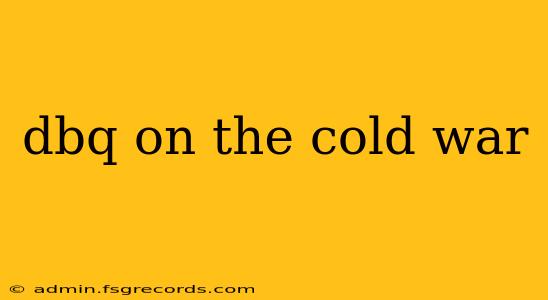The Cold War—a period of geopolitical tension between the United States and the Soviet Union and their respective allies—remains a significant topic in history. A Document-Based Question (DBQ) essay on this era requires a deep understanding of the historical context, the ability to analyze primary source documents, and the skill to craft a well-structured, persuasive argument. This guide will equip you with the strategies and insights needed to excel in your Cold War DBQ.
Understanding the Cold War Context
Before diving into the documents, establishing a strong foundational understanding of the Cold War is paramount. Key aspects to consider include:
- Ideological Conflict: The clash between capitalist democracy (US) and communist totalitarianism (USSR) fueled much of the Cold War tension. Understanding these ideologies and their implications is crucial.
- Nuclear Arms Race: The constant threat of nuclear annihilation shaped global politics and international relations, driving proxy conflicts and fueling anxieties.
- Proxy Wars: The Cold War wasn't just a direct confrontation; it played out through proxy wars in Korea, Vietnam, Afghanistan, and elsewhere, showcasing the global reach of the ideological struggle.
- Containment Policy: The US strategy of containment aimed to prevent the spread of communism, influencing decisions and actions throughout the Cold War.
- Détente and the End of the Cold War: Understanding the periods of relative calm (détente) and the eventual collapse of the Soviet Union provides crucial context for analyzing the historical narrative.
Analyzing Primary Source Documents: A Step-by-Step Approach
The heart of a DBQ lies in the analysis of primary source documents. Here's a structured approach:
-
Identify the Source Type: Is it a speech, letter, photograph, map, or something else? Understanding the source type helps determine its potential biases and perspectives.
-
Identify the Author/Creator: Who created the document? What was their position, perspective, and potential biases? This is crucial for evaluating the reliability and objectivity of the source.
-
Analyze the Content: What is the main idea or argument presented in the document? What evidence does the author provide to support their claims?
-
Identify Bias and Perspective: Every source has a perspective. Actively identify and analyze the biases present in the document and how they might shape the information presented.
-
Connect to Broader Context: How does this document relate to the larger historical context of the Cold War? How does it support or challenge existing narratives and interpretations?
Crafting a Strong Thesis Statement
Your thesis statement is the cornerstone of your DBQ essay. It should clearly state your argument about the Cold War, incorporating specific points supported by the documents. A strong thesis will:
- Take a Position: Clearly state your main argument about the Cold War's causes, consequences, or a specific aspect thereof.
- Be Specific: Avoid vague generalizations. Use specific examples and points that you will develop throughout the essay.
- Be Supported by Evidence: Your thesis should be directly supported by the evidence presented in the documents.
Structuring Your DBQ Essay
A well-structured essay enhances readability and strengthens your argument. A typical DBQ structure includes:
- Introduction: Introduce the historical context of the Cold War and clearly state your thesis statement.
- Body Paragraphs: Each body paragraph should analyze one or more documents, connecting them to your thesis and the broader historical context. Ensure you use multiple documents to support each point.
- Conclusion: Restate your thesis in a new way, summarizing your main points and offering a concluding thought about the significance of the Cold War.
Utilizing Outside Knowledge
While the documents are crucial, integrating your own outside knowledge strengthens your analysis. This demonstrates a deeper understanding of the subject matter and enables you to contextualize the documents effectively.
Mastering the Art of Synthesis
Synthesis is the key to a high-scoring DBQ. It's not enough to simply summarize the documents; you must weave them together to create a coherent and persuasive argument. Show how the documents relate to each other, how they support or contradict each other, and how they collectively support your thesis.
By following these steps, you can approach your Cold War DBQ with confidence, effectively analyzing the provided documents, constructing a compelling argument, and achieving a high score. Remember to practice regularly and seek feedback on your writing to refine your skills and master the art of DBQ essay writing.

